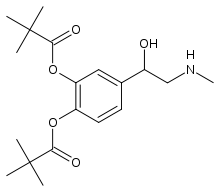Dipivefrine
 | |
| Systematic (IUPAC) name | |
|---|---|
| [2-(2,2-dimethylpropanoyloxy)-4- (1-hydroxy-2-methylamino-ethyl)- phenyl] 2,2-dimethylpropanoate | |
| Clinical data | |
| Trade names | Propine |
| AHFS/Drugs.com | International Drug Names |
| MedlinePlus | a686005 |
| |
| Identifiers | |
|
52365-63-6 | |
| S01EA02 | |
| PubChem | CID 3105 |
| DrugBank |
DB00449 |
| ChemSpider |
2994 |
| UNII |
8Q1PVL543G |
| KEGG |
D02349 |
| ChEBI |
CHEBI:4646 |
| ChEMBL |
CHEMBL1201262 |
| Chemical data | |
| Formula | C19H29NO5 |
| 351.437 g/mol | |
|
SMILES
| |
| |
| | |
Dipivefrin (trade name Propine) is a prodrug of epinephrine, and is used to treat open-angle glaucoma.[1] It is available as a 0.1% ophthalmic solution.
Mechanism of action
The drug when applied over the cornea, penetrates it and is then hydrolysed to epinephrine by the esterases. It increases uveosacral outflow and also reduces aqueous formation (an α1 and α2 mediated action), thus reducing the intraocular pressure. It also increases the hydraulic conductivity of trabecular filtering cells (a β2 mediated action). It is preferred to epinephrine because it is longer acting, more consistent in its action and has better ocular tolerance.[1]
References
| ||||||||||||||||||||||||||||||||||||||||||||||||||||||